We may earn revenue from the products available on this page and participate in affiliate programs. Learn More ›
|
Best Lightweight
|
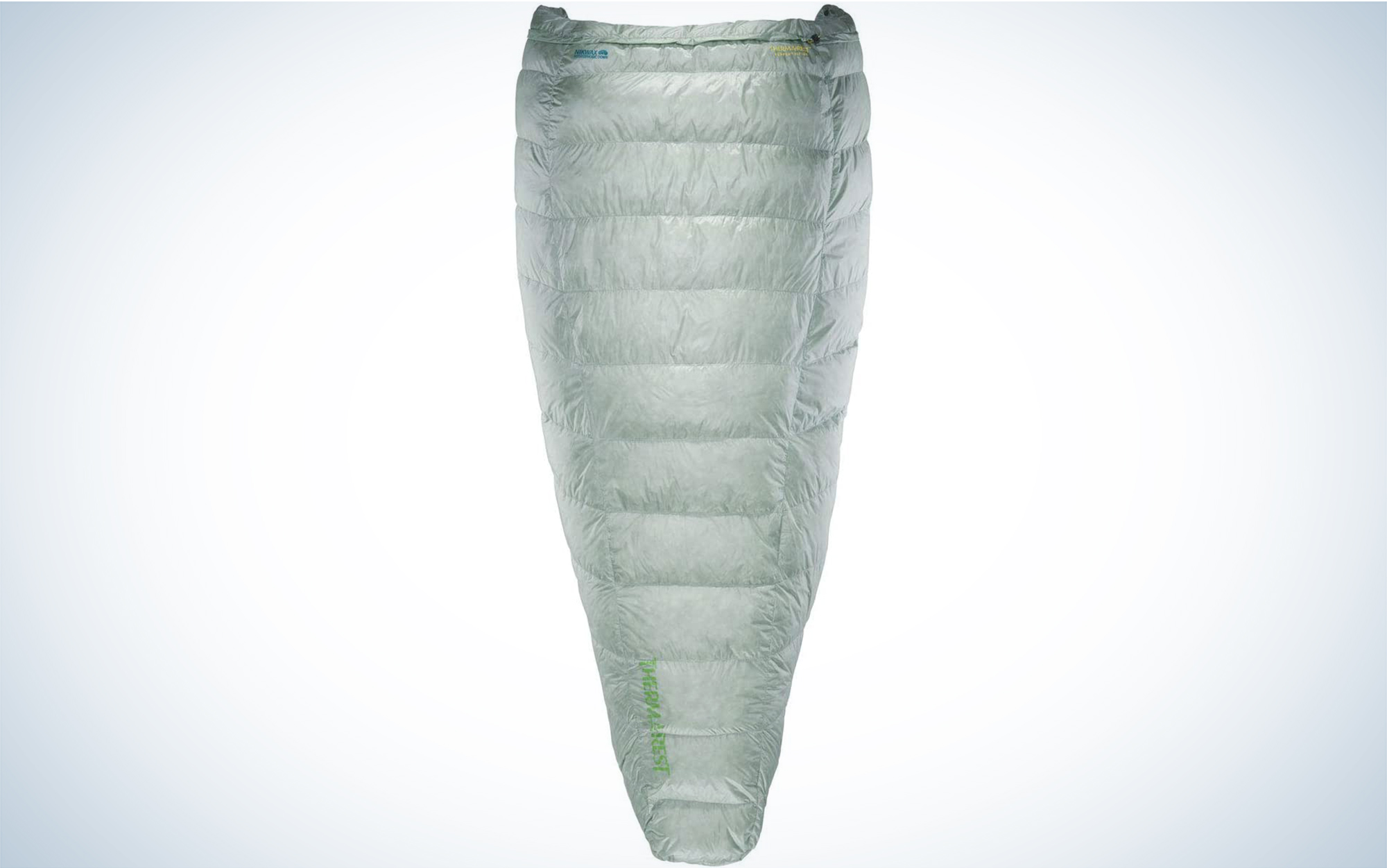
|
Therm-a-Rest Vesper
|
SEE IT
|
|
Best Draft Protection
|
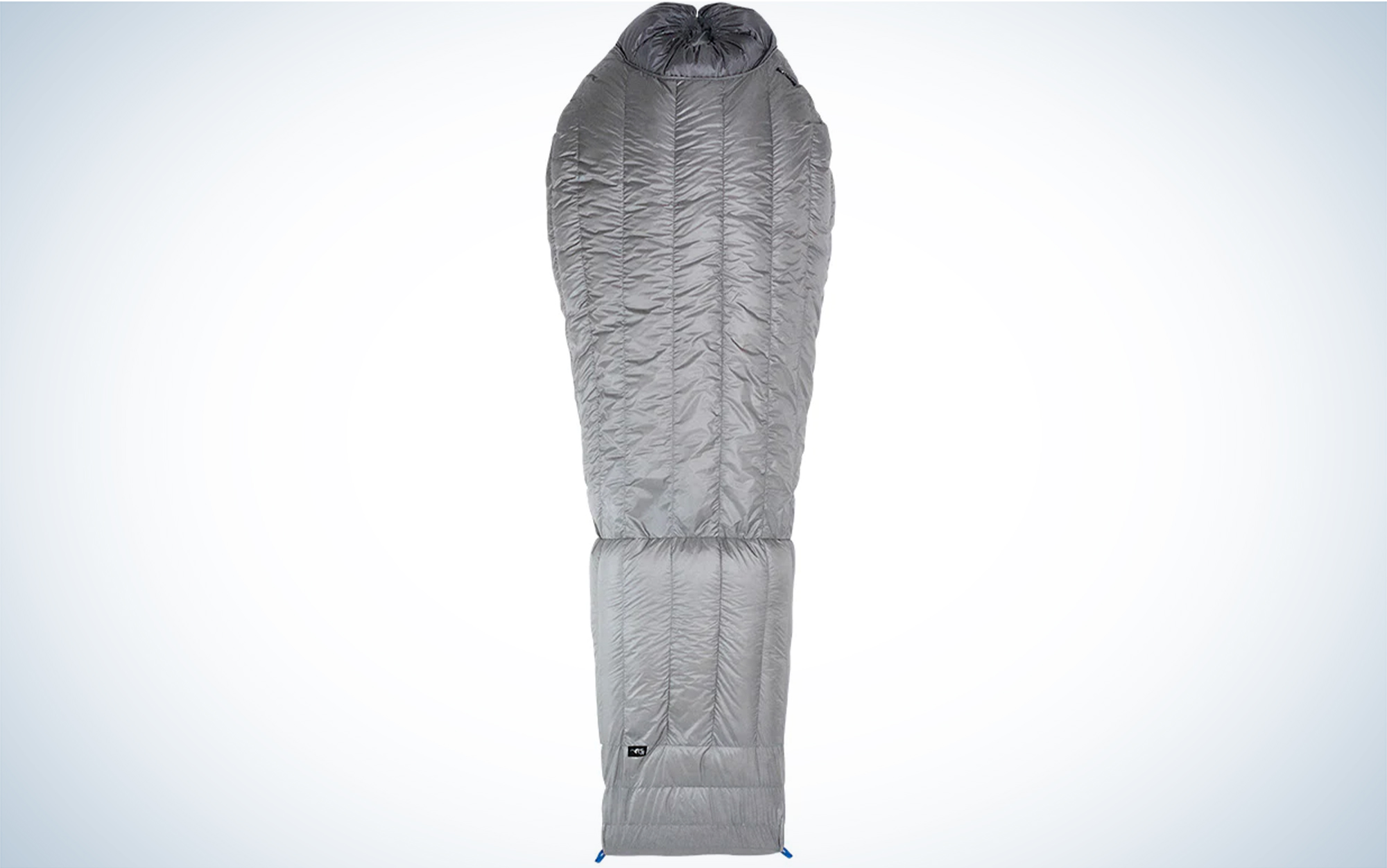
|
Stone Glacier Chilkoot
|
SEE IT
|
|
Best Customization
|
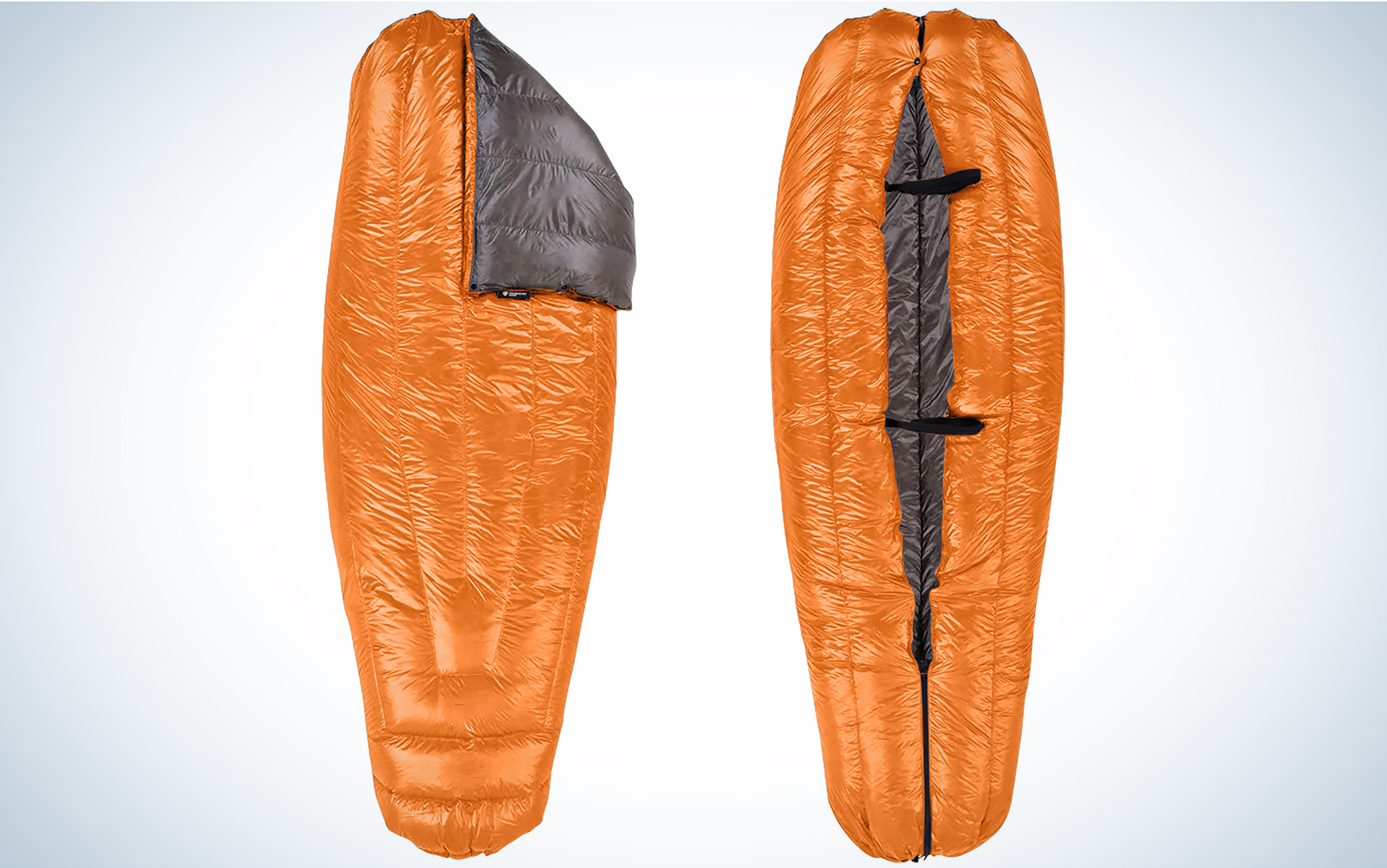
|
Enlightened Equipment Revelation
|
SEE IT
|
If you’ve been looking at lightening your backcountry kit, odds are you’ve considered swapping out your sleeping bag for a sleeping quilt. But, for many, the idea of ditching the backside of their sleeping bag sounds crazy: like asking someone to carry a tote instead of a backpack, or use a tarp instead of a tent (actually that second one isn’t a bad idea either). But after using some of the best backpacking quilts for almost a decade, I’m confident that just about everyone will appreciate the weight savings and added comfort compared to even best-in-class sleeping bags.
- Best Lightweight: Therm-a-Rest Vesper
- Best Draft Protection: Stone Glacier Chilkoot
- Best Customization: Enlightened Equipment Revelation
- Best for Hot Nights: Sea to Summit Ember
- Best for Couples: Enlightened Equipment Accomplice
Why You Should Make the Switch
The idea here is simple: the down (or synthetic fill, which is just mimicking down anyway) in your sleeping bag works by trapping hot air inside the “pockets” created by the innumerable filaments on each feather, insulating you from the cold. The parts of the sleeping bag that your body is lying on are crushing the down: so, no pockets of hot air, no added insulation. If you eliminate the bottom of your sleeping bag, then you will save on weight for a negligible loss of warmth (there’s a catch here). Side sleepers and stomach sleepers also find that sleeping quilts give them more flexibility of movement—especially compared to the aptly named mummy bags.
The catch is that you must pair a sleeping quilt with an appropriately R-rated backpacking sleeping pad. While it’s not the highest and best use of down to squash it beneath your body, it does provide some insulation if you’re out in shoulder season conditions with a closed-cell-foam pad (or even nothing at all). Plan on at least an R rating of 4 if you intend to use your quilt for alpine or shoulder season camping.
Best Lightweight: Therm-a-Rest Vesper
Why It Made the Cut
This surprisingly roomy quilt weighs less than a pound and is appropriate for shoulder season temps.
Key Features
- Temperature Ratings: 45 degree, 32 degree, and 20 degree
- Size: Fits up to 6 foot individual (regular), 6 feet 4 inches (long)
- Weight: 12 ounce (45 degree, regular), 15 ounces (32 degrees, regular), 19 ounce (20 degree, regular)
- Fill: 900fp Nikwax hydrophobic goose down
- Fill Weight: 6 ounces (45 degrees), 8.5 ounces (32 degree), 12.5 ounces (20 degree)
- Material: 10D ripstop nylon (DWR on shell fabric only)
- Three attached, non-adjustable, elastic underpad straps
- Drawstring at neck with snap-button closure
Pros
- Lightweight
- Wide design helps prevent drafts
Cons
- Unusually narrow footbox
- Straps were not as secure around the bottom of the pad as others I looked at
Product Description
If you’re considering switching to a quilt for weight savings, then you should look seriously at the Therm-a-Rest Vesper. At 15 ounces for a 72-inch quilt rated for 32-degree temps, it is the lightest quilt that I looked at by several ounces. And, impressively, it’s not achieving that by scrimping on width (58 inches at the shoulders). I came to appreciate just how wide the Vesper is after an unfortunate night when my three-year-old decided that her sleeping bag was garbage and she was going to share this quilt with me instead. I didn’t sleep well that night, but the quilt had no trouble covering both of us.
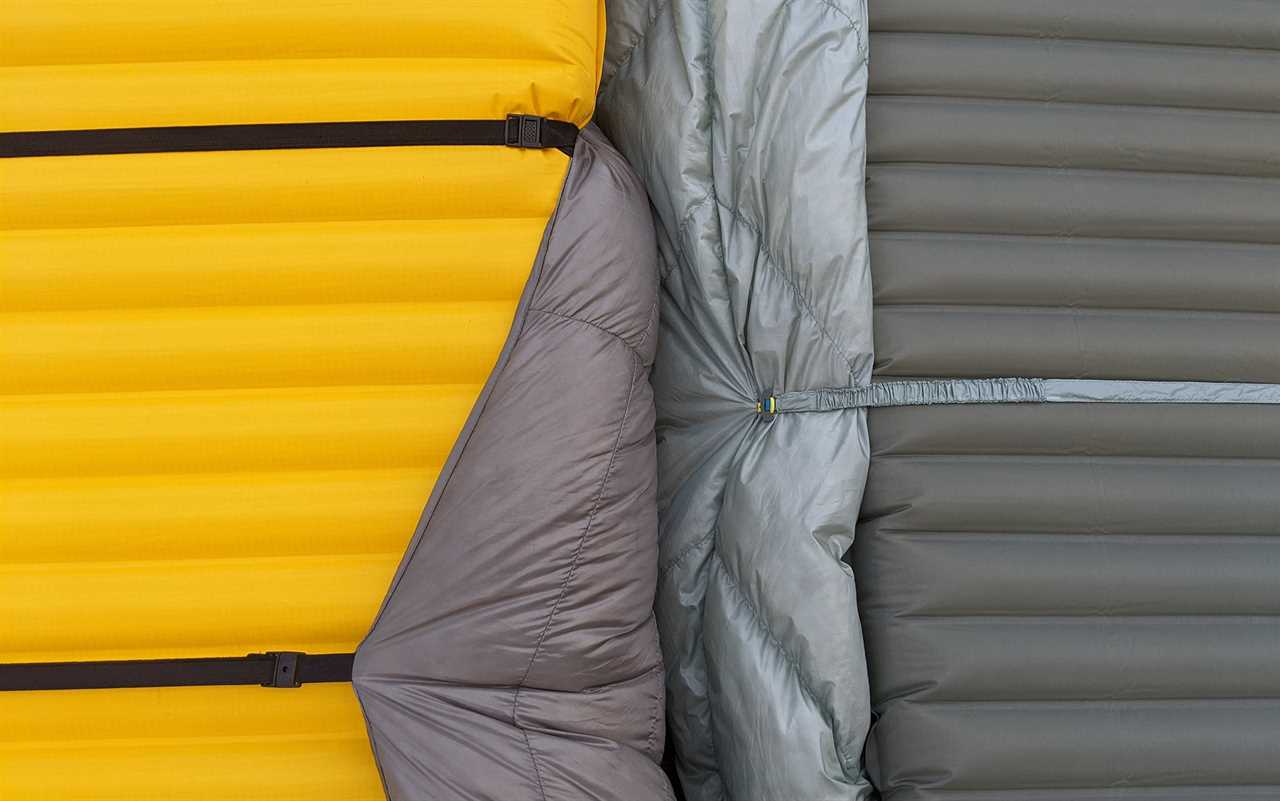
Despite being non-adjustable, I experienced no drafts while testing the Therm-a-Rest Vesper. Laura Lancaster
The Therm-a-Rest Vesper has a different strategy for preventing drafts than other quilts I looked at. Whereas the others used adjustable straps—so that you can cinch down the edges of your quilt to the edge of your sleeping pad, the Vesper has loose-fitting, non-adjustable straps with a bit of bungee in them that—and this is an important detail—attach a few inches above the side seam on either side. This creates a buffer for restless sleepers: the loose straps and wide profile let you toss and turn, the bungee pulls the quilt back into place, and the extra material below the strap prevents a draft from getting in. This doesn’t look or feel like it should be able to keep out drafts, but it does. (See above about sharing this quilt with a toddler.)
My only real gripe about this quilt is the footbox, which is exceedingly narrow. It feels odd to have all this room to toss and turn in, getting into as comfortable a position as you can while backpacking, and then have this super narrow footbox to slide your foot into. This goes double if your preference is to tuck the footbox of this quilt into your Therm-a-Rest NeoAir, which renders it almost unusable.
Best Draft Protection: Stone Glacier Chilkoot 32°
Why It Made the Cut
Four pad straps, a closed footbox, and a unique collar design make the Stone Glacier the best at keeping out unwanted drafts on chilly nights.
Key Features
- Temperature Ratings: 32 degree, 15 degree, and 0 degree
- Size: Fits people up to 6 feet 5 inches
- Weight: 22.6 ounces (32 degree), 35 ounces (15 degree), 42 ounces (0 degree)
- Fill: 850fp HyperDRY goose down
- Fill Weight: 12 ounces (32 degree), 22.4 ounces (15 degree), 29.1 ounces (0 degree)
- Material: 15D Pertex® Quantum Shell
- Four adjustable underpad straps (two attached, two removable)
- Magnet closure at neck with elastic
Pros
- Long
- Closed footbox and multiple underpad straps reduce drafts
- Baffle design prevents down from moving around too much
- Magnet at collar is easy to take on and off at night
Cons
- Heavier than other options
- Shorter individuals may find this is more bag than they need
Product Description
Probably the biggest reason people don’t switch to sleeping quilts is that they are (rightly) concerned about drafts. If the quilt is 1) open on the bottom and 2) easy to toss and turn in, what’s to stop you from waking up in the middle of the night, shivering, with half the quilt off your body?
Just about all sleeping quilts solve this problem by incorporating some combination of underpad straps, a closed footbox, and the ability to cinch up the collar, but the Stone Glacier Chilkoot takes this a step further. Instead of stopping at two, or even three underpad straps, the Chilkoot has four. (Of these, two are removable, so you can save a couple of grams of weight if necessary.) But what really stood out to me about the Chilkoot was the collar. Most sleeping quilts have an adjustable drawcord at the neck so that you can cinch down the top opening of the quilt on especially cold nights, a feature that I tend to use as little as possible as it’s hard to find a middle ground between “so loose you might as well not have bothered” and “I feel like I’m choking.”
The Chilkoot has a light elastic band (emphasis on light) at the collar that conforms to your neck. Even better, it uses a magnet to close, a detail that I hope other quilt manufacturers will take note of. (If you’ve ever woken up in the middle of the night desperately needing to pee and spent what feels like five minutes groggily trying to find the snap-button or cinch cord at the collar of your sleeping bag then the utility of this detail will make perfect sense to you.)
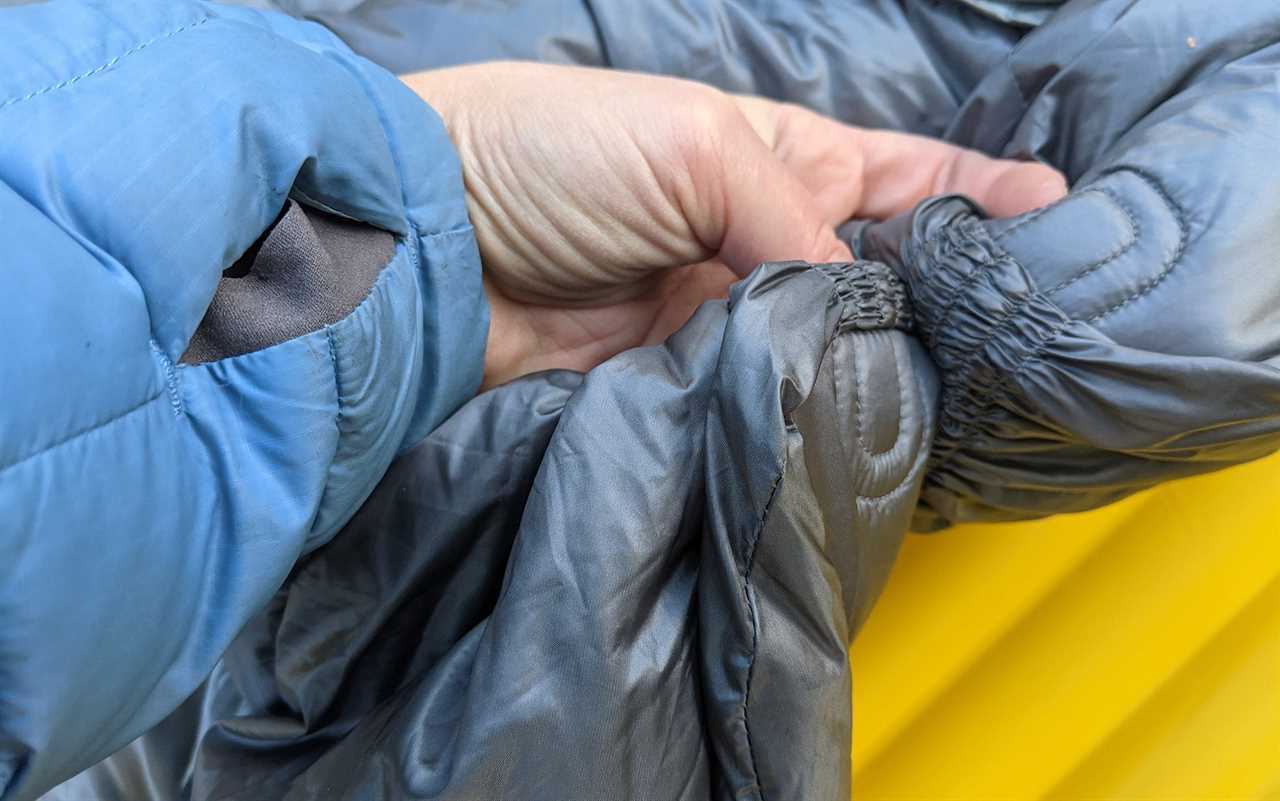
The Stone Glacier Chilkoot swaps out the typical cinch cord and snap-button tab at the collar in favor of a magnet and lightweight elastic. Laura Lancaster
While the closed footbox here is similar to the style of the Therm-a-Rest Vesper, it’s not going to feel nearly as cramped for one simple reason: this quilt is extremely long—after testing it out on my resident 6 foot 3 inch individual, I’m confident that it will easily fit someone 6 feet 5 inches or taller. Even when placed on the long version of the Therm-a-Rest NeoAir, the footbox hung off the end of the pad. (On especially cold nights, you can help insulate your feet from the cold of the ground by sliding your backpack underneath the footbox).
Best Customization: Enlightened Equipment Revelation
Why It Made the Cut
Long lead times are offset by a noticeably lower price point and the ability to select exactly the right size and fill power you need for your adventures.
Key Features
- Temperature Ratings: 0 degree, 10 degree, 20 degree, 30 degree, 40 degree, and 50 degree
- Size: Five size options for individuals from 5 feet to 7 feet tall
- Weight: highly variable depending on your chosen specifications
- Fill: 850fp or 950fp
- Fill Weight: Highly variable depending on your chosen specifications
- Material: 7D, 10D, or 20D DWR nylon
- Three removable, adjustable underpad straps
- Drawstring at neck with snap-button closure
Pros
- Customize height, width, fill power, and more
- Less expensive than other quilts I looked at (but still pricey)
Cons
- Long lead time if your measurements aren’t currently in stock—order this at least a month in advance of when you’ll need it
Product Description
If you’ve been eyeing quilts for a while—maybe you even already own one—you probably are starting to get a pretty good idea of what you need. The height. The width. How warm you want your quilt to be. How much you’re willing to spring for a higher fill power to save a few ounces. If that sounds like you then you should look seriously at the Enlightened Equipment Revelation.
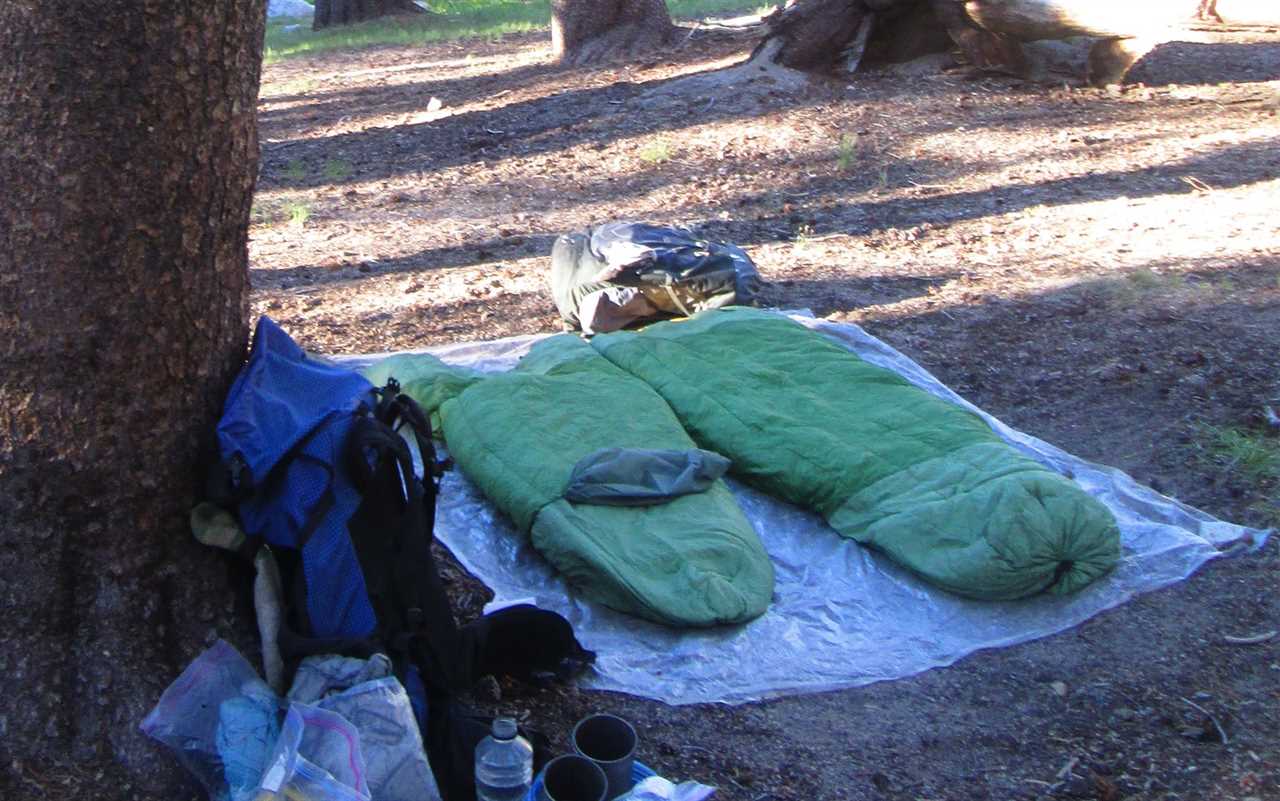
One of my family’s first set of Enlightened Equipment quilts, out on the Pacific Crest Trail in 2014. Ashley Thess
Currently, Enlightened Equipment offers their quilts in five different heights—which will fit everyone from 5 feet to 7 feet—and four different widths. You can choose temperature ratings in 10-degree increments, from 50 degrees Fahrenheit down to 0 degrees Fahrenheit, and between 850 fill power and 950 fill power (there is a significant cost increase with going with the higher fill power, although also a noticeable weight savings). You can even choose your own color.
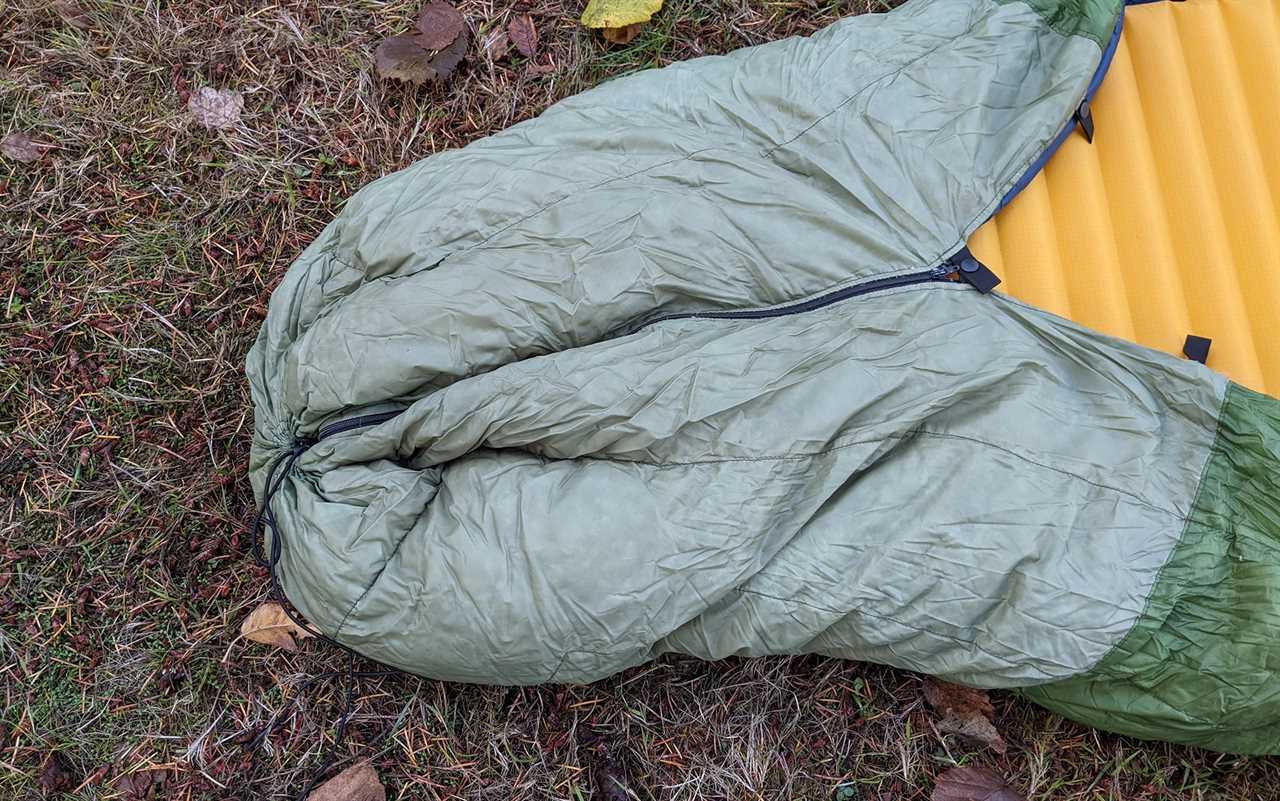
A zipper, cinch cord, and a pair of snap tabs allows you to switch between a closed footbox and completely open quilt with the Enlightened Equipment Revelation. Laura Lancaster
Unlike the Therm-a-Rest Vesper and Stone Glacier Chilkoot, you can switch between having a closed footbox and a completely open quilt (useful when it gets unexpectedly hot). The catch is that if you aren’t careful with how you close the bottom of the quilt (which has a drawstring, a clasp, and a zipper) then it’s relatively easy for a draft to sneak in.
Best for Hot Nights: Sea to Summit Ember
Why It Made the Cut
Individuals who run hot may find some functionality in this sleeping quilt; otherwise, this is best suited for warm weather adventures only.
- Temperature Ratings: 50 degree, 35 degree, and 25 degree
- Size: Fits individuals up to 6 feet (regular), 6 feet 6 inches (long)
- Weight: 14.8 ounces (50 degree, regular), 21.2 ounces (35 degree, regular), 25.6 ounces (25 degree, regular)
- Fill: 850fp ultra-dry down
- Fill Weight: 7.1 ounces (50 degree), 12.3 ounces (35 degree), 17.6 ounces (25 degree)
- Material: 10D nylon
- Four adjustable, removable underpad straps
- Drawstring at neck with snap-button closure
Pros
- Somewhat inexpensive (although not the least expensive on this list)
Cons
- Worst footbox of the quilts I looked at
- Lowest fill power I looked at
Product Description
If the whole reason you’re looking to purchase a quilt is that you’re tired of overheating in your sleeping bag on hot summer nights, then this might work for you—everyone else, pick something else from this list.

There is no way to keep drafts out of the footbox of the Sea to Summit Ember. Laura Lancaster
The trouble with this quilt is that the footbox doesn’t close up fully, making it closer to one of the best camping blankets than a quilt. The single cinch cord at the bottom just doesn’t cut it. Your only option here for keeping out cold air drafts is to 1) be a small enough person that there is no way the quilt would flip in the night or 2) not move much if at all while you sleep. Strangely, I found that when I flipped the quilt around and tried cinching up a footbox where, theoretically, my head was supposed to go, that this worked better, thanks to the presence of snap-button.
Best for Couples: Enlightened Equipment Accomplice
Why It Made the Cut
The spaciousness, draft control, and warmth of this two-person quilt makes it my go-to for backpacking with family members.
Key Features
- Temperature Ratings: 0 degree, 10 degree, 20 degree, 30 degree, 40 degree, and 50 degree
- Size: Three size options for individuals from 5 feet 6 inches to 7 feet tall
- Weight: Highly variable depending on your chosen specifications
- Fill: 850fp or 950fp
- Fill Weight: Highly variable depending on your chosen specifications
- Material: 7D, 10D or 20D DWR nylon
- Three removable, adjustable underpad straps
- Drawstring at neck with snap-button closure
Pros
- Great draft prevention
- Wide enough to comfortably fit two people
- Underpad straps connect to two pads
- Customization options
Cons
Product Description
When I first bought this sleeping quilt, I thought it would be something my husband and I would use on the occasional trip—when the weather was dicey or we were heading out for a winter trip. Sleeping that closely next to someone just sounded like a recipe for a restless night—surely we would fight over the sides of the quilt, or kick each other in the night, every shift on the sleeping pad letting some draft or another sneak in?
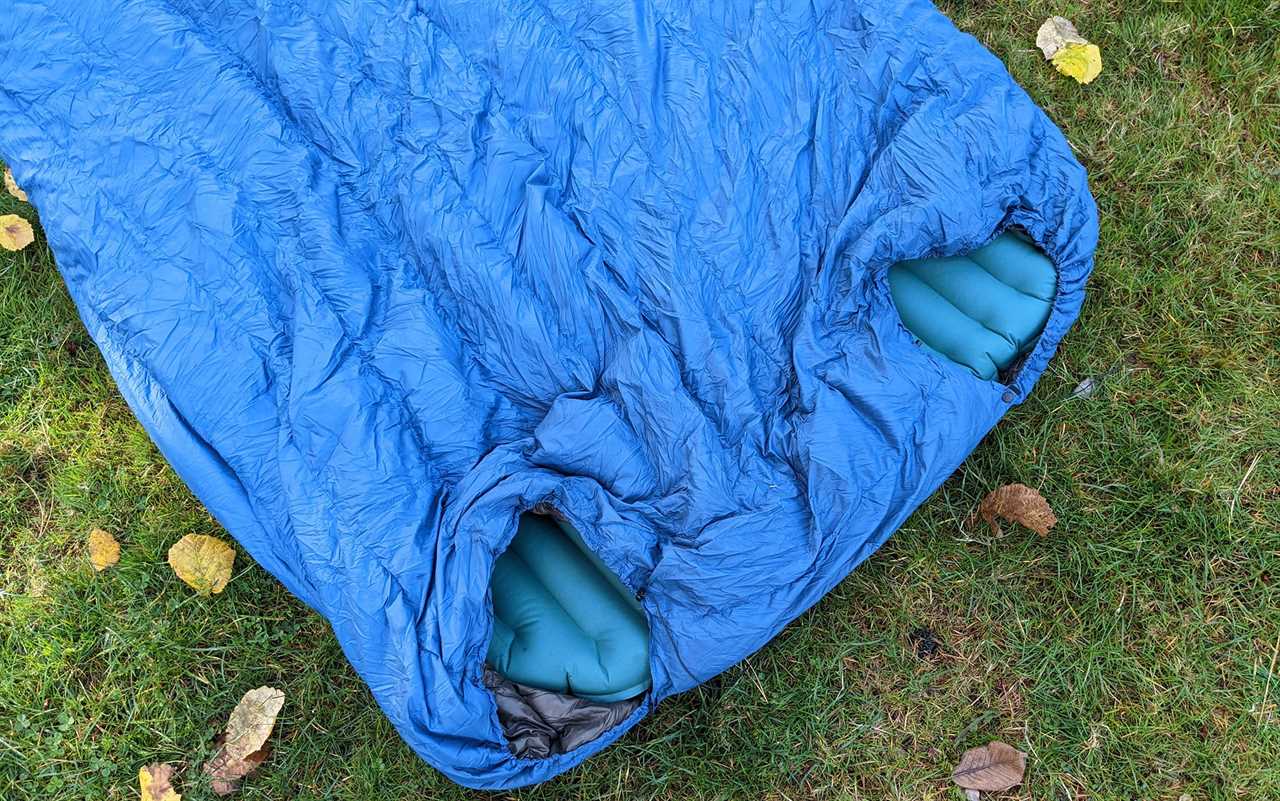
The double-collar design of the Enlightened Equipment Accomplice prevents unwanted drafts from sneaking in when your partner rolls over. Laura Lancaster
But it’s since become our standard sleeping quilt (it’s even what I use now when heading out on short backpacking trips with our preschooler), and I’ve never slept better. The reason for this is a number of thoughtful design features built into the quilt. Like the one-person Revelation, the Accomplice uses underpad straps that connect individually to two sleeping pads to help ensure that there are no cold air sneaking in on either edge of the quilt—this also means that there is no way for your partner (or you) to steal the covers. Next is the wide, tapered, closed footbox, which helps to keep out drafts while giving your feet someplace to go. But the real clutch addition here is the extra flap in-between your heads at the top of the quilt. This prevents a gap from forming at the top of the sleeping bag when your partner turns over, so you get all the benefits of their additional body heat, with none of the downsides.
Things to Consider Before Buying a Sleeping Quilt
The R Rating of Your Sleeping Pad
Again: you must have an appropriately rated backpacking sleeping pad when using a quilt. If you’ve been using something that is rated to a 2 or lower, especially if its closed-cell foam—look at upgrading to one of the best backpacking sleeping pads. An R-rating of 3 is a good benchmark for trips in the summer months, while a 4 or higher is a better bet if you plan to use your sleeping quilt during the shoulder seasons or in the alpine.
Temperature Rating
Anyone who has ever purchased a sleeping bag with a temperature rating knows these are a bit of BS. And how could they not be? What’s comfortable for one person in 50-degree weather will leave another person shivering—different bodies just naturally produce different amounts of body heat. At least with sleeping bags, there is some kind of standard that the brands adhere to (look for the acronyms EN or ISO—the European and American third-party ratings, respectively), meaning that you can at least be sure you are comparing apples to apples. Sleeping quilts, however, are even more of a mess, as there is no agreed-upon standards that manufacturers are bound to. Everyone is just kind of winging it, based on their own in-house protocols (some of which are very good, of course).
That’s all to say that you should not purchase a 20-degree quilt if you are planning to head out into temps that are actually 20 degrees Fahrenheit—not unless you know your resting body temperature is closer to “surface of the sun” than a standard 98.6 degrees. The temperature ratings are meant to signify the lowest temperature at which it’s safe to use a given sleeping bag or sleeping quilt anyway, not the temperature at which you are going to be comfortable (or, you know, actually sleep). I typically use a 20-degree quilt for the summer months and a 10-degree quilt in the winter.
Fill
The best backpacking quilts are made from down for one simple reason: It still has superior warmth-to-weight ratios compared to synthetic fill (and if you’re looking at backpacking quilts, cutting weight is likely one of the reasons). With down, the higher the fill power the less you’ll need to reach your desired temperature rating, and thus the less your sleeping quilt will weigh. But the difference between, say 850 fp and 950 fp for a sleeping quilt might only be a couple of ounces but cost upwards of $100. Consider your priorities when choosing which one is the right pick for you.
Material
The majority of backpacking quilts use nylon to encase the down, often with a DWR (durable water repellent) finish on the part of the quilt that is exposed to the outside air (the shell). Where most differ is in the level of thickness of the nylon—measured in denier—which can be anywhere from 7D up to 20D.
Baffle Design
While most people are restricted in the amount of shuffling around they can do in a sleeping bag, your new-found ability to actually get into a comfortable position in a backpacking quilt comes with a small problem: you can inadvertently shuffle the down to one side of the baffle or the other, resulting in cold spots on your quilt that can impact how warm you are. Be wary of sleeping quilts with completely horizontal baffle designs.
Storage
Some sleeping quilts come with compression sacks, but it’s not necessary to use this feature; in fact, you can skip the stuff sack entirely and squash your backpacking quilt to the bottom of your bag before piling other items on top (just be careful that you don’t snag anything on your bag). Like with down-filled sleeping bags, it’s best to store your sleeping quilt in a larger stuff sack at home, as this will extend the longevity of your quilt.
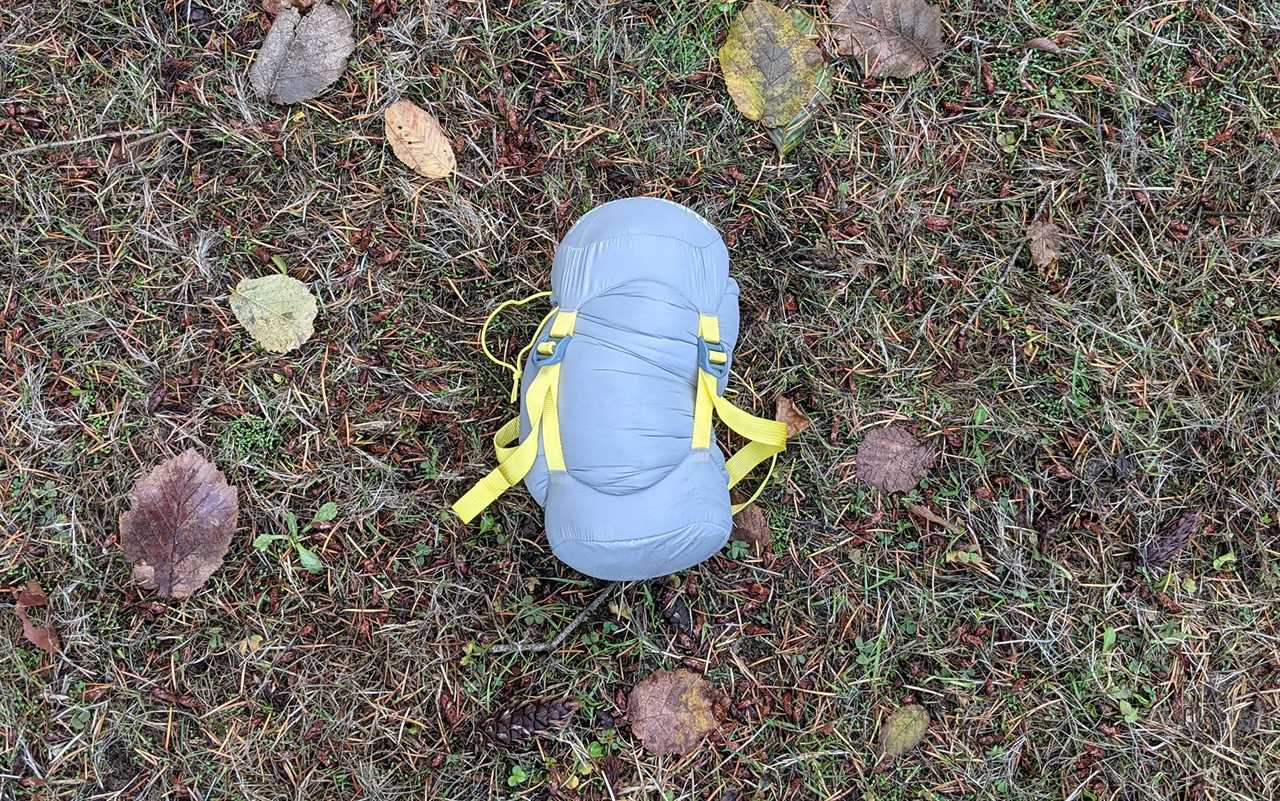
Laura Lancaster
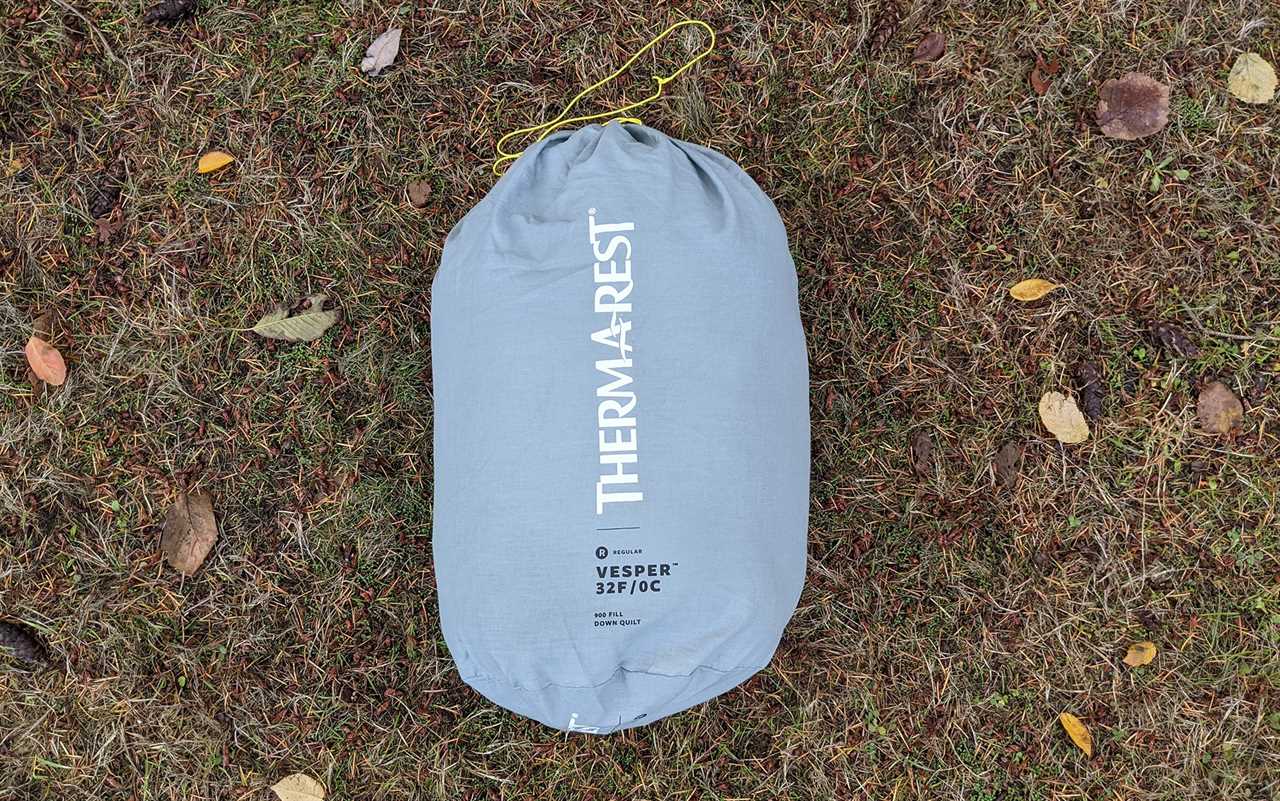
Laura Lancaster
The Therm-a-Rest Vesper packed for travel versus packed for long-term storage.
Footbox
Some sleeping quilts have a fully enclosed footbox while others allow you to switch between a closed footbox and a completely open quilt—useful when you expect to oscillate between warmer lowland and colder alpine temps during a single trip. The disadvantage of closed footboxes is that they make the quilt less versatile (if, say, you hit a spell of unseasonably warm weather; the disadvantage to adjustable footboxes is that they add a bit of weight (through a cinch cord at the bottom as well as a zipper).
Straps
Most, although not all, quilts have straps underneath them, which are used to secure the quilt to the sleeping pad. In my opinion, these are necessary to keep drafts out.
How I Chose the Best Sleeping Quilts
I’ve used sleeping quilts for hundreds of nights over almost a decade, in conditions ranging from blazing summer nights to surprise September snows, while winter camping and cowboy camping above treeline. In that time, I’ve learned a lot about what makes for a negative quilt experience (the wrong sleeping pad, drafts sneaking in) and how to optimize your experience for the best night’s sleep possible.

My family made the switch from sleeping bags to quilts almost a decade ago. Laura Lancaster
For this story, I looked at both quilt manufacturers that have been around for years as well as those produced by the biggest brand names in outdoor recreation gear and newer entrees to the marketplace.
FAQs
Q: Are backpacking quilts good for side sleepers?
Backpacking quilts are an excellent choice for side sleepers because they restrict your movement less than both mummy bags and traditional rectangular sleeping bags and, in warmer environments, can be opened up to allow for as much range as motion as you would have in your bed at home.
Q: Are quilts warmer than sleeping bags?
Quilts are not warmer than sleeping bags so much as they can provide more warmth per ounce of weight in your pack, if paired with an appropriate backpacking sleeping pad. It’s strongly recommended that you test your quilt setup at home before taking it out into the field for the first time.
Q: How do you sleep comfortably while backpacking?
There are a number of things you can do to improve your sleep experience while backpacking, including choosing a comfortable backpacking sleeping pad with an appropriate R rating for the conditions you expect to find yourself in, choosing the right backpacking quilt for your needs, based on the above recommendations, which will allow for a greater range of movement while sleeping, and choosing one of the best backpacking pillows.
Final Thoughts
Most people who make the switch from the sleeping bags to the sleeping quilts never look back, for one simple reason: There is so much more versatility to the best backpacking quilts. You’re no longer restricted to the dreaded “mummy” position (can even dedicated back sleepers doze off like that?) or forced, in warmer climes, to choose between having the right side of your body enduring an uncomfortable draft while the left side sweats. After that, the weight savings start to seem like an added bonus, rather than the primary reason you looked at making the switch in the first place.
The post The Best Backpacking Quilts of 2022 appeared first on Outdoor Life.
By: Laura Lancaster
Title: The Best Backpacking Quilts of 2022
Sourced From: www.outdoorlife.com/gear/best-backpacking-quilts/
Published Date: Wed, 09 Nov 2022 22:30:00 +0000
----------------------------------------------
Did you miss our previous article...
https://manstuffnews.com/weekend-warriors/how-to-sight-in-a-rifle
 Backyard GrillingWeekend WarriorsAdvice from DadBeard GroomingTV Shows for Guys4x4 Off-Road CarsMens FashionSports NewsAncient Archeology World NewsPrivacy PolicyTerms And Conditions
Backyard GrillingWeekend WarriorsAdvice from DadBeard GroomingTV Shows for Guys4x4 Off-Road CarsMens FashionSports NewsAncient Archeology World NewsPrivacy PolicyTerms And Conditions
